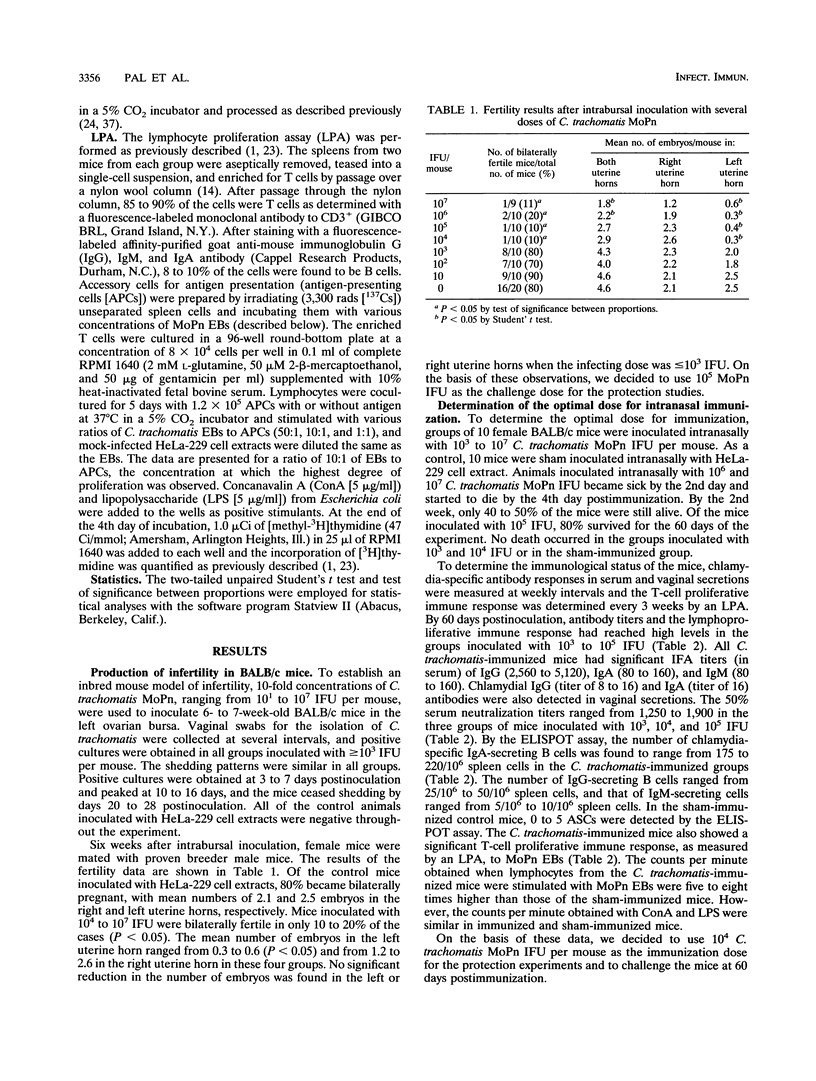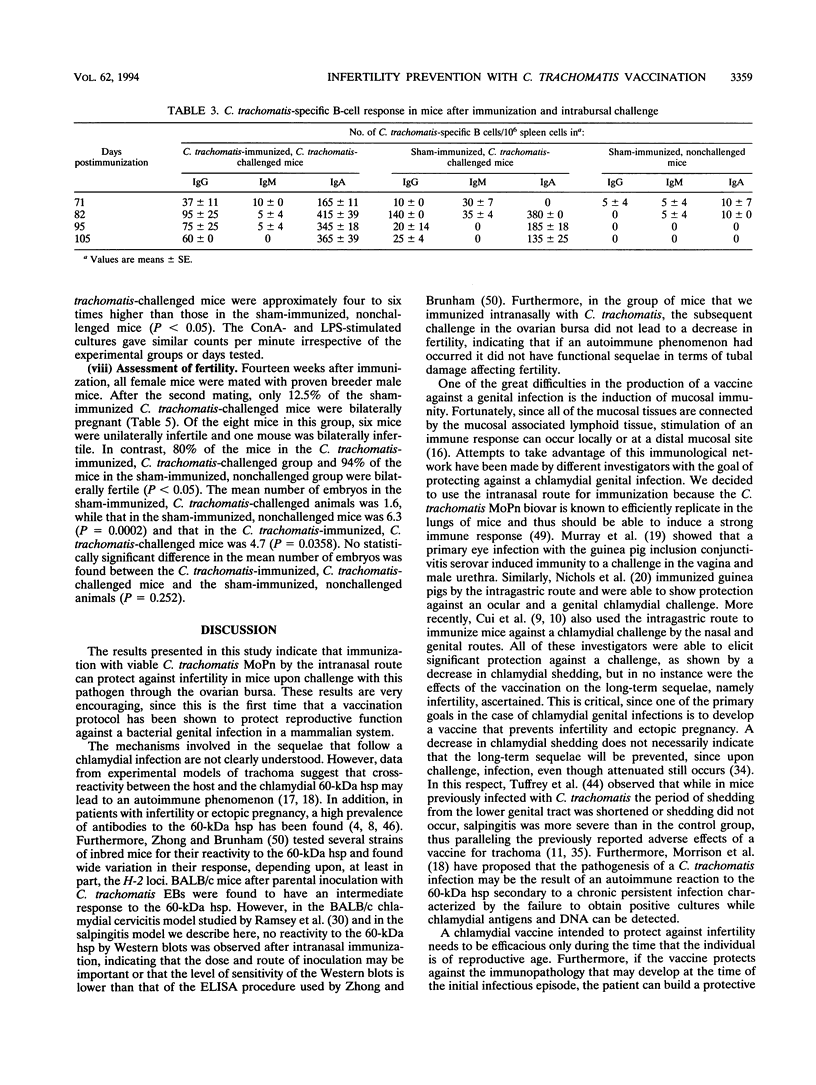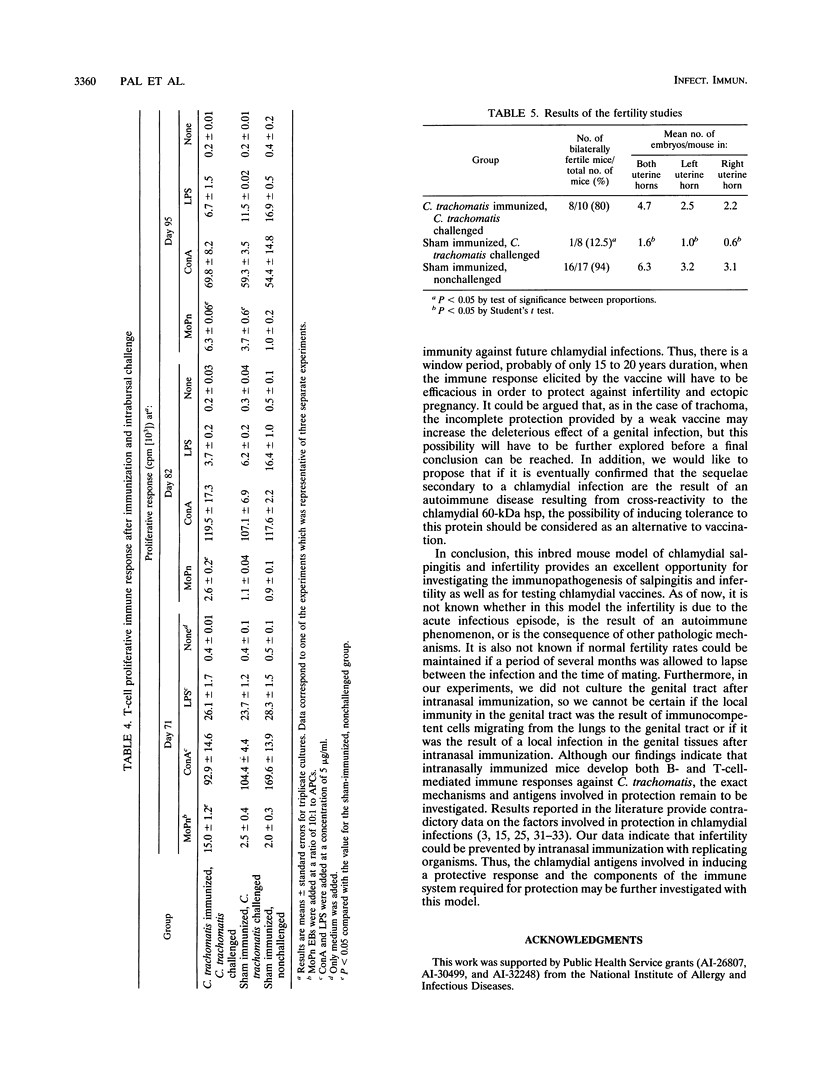Abstract
Female BALB/c mice were immunized intranasally with the mouse pneumonitis biovar of Chlamydia trachomatis and subsequently challenged in the ovarian bursa (C. trachomatis immunized, C. trachomatis challenged). Two groups of mice served as controls. One group was sham immunized intranasally with mock-infected HeLa 229 cell extracts and was challenged in the ovarian bursa with C. trachomatis MoPn (sham immunized, C. trachomatis challenged). The second control group was sham immunized and not challenged (sham immunized, nonchallenged). Before challenge, the C. trachomatis-immunized, C. trachomatis-challenged animals mounted a significant humoral response as shown by high immunoglobulin G (IgG), IgM, and IgA levels and high levels of neutralizing antibodies in serum and moderate IgG and IgA titers in vaginal secretions. Reactivity by Western blot (immunoblot) to the lipopolysaccharide, 30-, 40- (major outer membrane protein), and 60-kDa cysteine-rich proteins and 75- and 100-kDa chlamydial components could be demonstrated. However, reactivity to the 60-kDa heat shock protein was only observed 22 days after challenge. In addition, this group of animals mounted a significant immune response to chlamydial antigens, as shown by a lymphocyte proliferation assay, compared with the sham-immunized nonchallenged mice. After intrabursal challenge, there was no C. trachomatis shedding from the vagina in the C. trachomatis-immunized, C. trachomatis-challenged animals, while 63% of the sham-immunized, C. trachomatis-challenged mice had a positive C. trachomatis culture. In addition, histological sections from the genital tract showed, at 2 weeks postchallenge, a marked acute inflammatory reaction in the sham-immunized, C. trachomatis-challenged animals while in the C. trachomatis-immunized, C. trachomatis-challenged mice there was minimal inflammatory reaction. When the animals were mated, only 12% of the mice from the sham-immunized, C. trachomatis-challenged mice were fertile. In contrast, 94 and 80% of the sham-immunized, nonchallenged and C. trachomatis-immunized, C. trachomatis-challenged mice, respectively, were fertile.
Full text
PDF








Selected References
These references are in PubMed. This may not be the complete list of references from this article.
- Allen J. E., Locksley R. M., Stephens R. S. A single peptide from the major outer membrane protein of Chlamydia trachomatis elicits T cell help for the production of antibodies to protective determinants. J Immunol. 1991 Jul 15;147(2):674–679. [PubMed] [Google Scholar]
- Brunham R. C., Binns B., McDowell J., Paraskevas M. Chlamydia trachomatis infection in women with ectopic pregnancy. Obstet Gynecol. 1986 May;67(5):722–726. doi: 10.1097/00006250-198605000-00022. [DOI] [PubMed] [Google Scholar]
- Brunham R. C., Kuo C. C., Cles L., Holmes K. K. Correlation of host immune response with quantitative recovery of Chlamydia trachomatis from the human endocervix. Infect Immun. 1983 Mar;39(3):1491–1494. doi: 10.1128/iai.39.3.1491-1494.1983. [DOI] [PMC free article] [PubMed] [Google Scholar]
- Brunham R. C., Maclean I. W., Binns B., Peeling R. W. Chlamydia trachomatis: its role in tubal infertility. J Infect Dis. 1985 Dec;152(6):1275–1282. doi: 10.1093/infdis/152.6.1275. [DOI] [PubMed] [Google Scholar]
- Brunham R. C., Peeling R., Maclean I., Kosseim M. L., Paraskevas M. Chlamydia trachomatis-associated ectopic pregnancy: serologic and histologic correlates. J Infect Dis. 1992 Jun;165(6):1076–1081. doi: 10.1093/infdis/165.6.1076. [DOI] [PubMed] [Google Scholar]
- Caldwell H. D., Kromhout J., Schachter J. Purification and partial characterization of the major outer membrane protein of Chlamydia trachomatis. Infect Immun. 1981 Mar;31(3):1161–1176. doi: 10.1128/iai.31.3.1161-1176.1981. [DOI] [PMC free article] [PubMed] [Google Scholar]
- Chow J. M., Yonekura M. L., Richwald G. A., Greenland S., Sweet R. L., Schachter J. The association between Chlamydia trachomatis and ectopic pregnancy. A matched-pair, case-control study. JAMA. 1990 Jun 20;263(23):3164–3167. [PubMed] [Google Scholar]
- Coles A. M., Crosby H. A., Pearce J. H. Analysis of the human serological response to Chlamydia trachomatis 60-kDa proteins by two-dimensional electrophoresis and immunoblotting. FEMS Microbiol Lett. 1991 Jul 1;65(3):299–303. doi: 10.1016/0378-1097(91)90231-x. [DOI] [PubMed] [Google Scholar]
- Cui Z. D., LaScolea L. J., Jr, Fisher J., Ogra P. L. Immunoprophylaxis of Chlamydia trachomatis lymphogranuloma venereum pneumonitis in mice by oral immunization. Infect Immun. 1989 Mar;57(3):739–744. doi: 10.1128/iai.57.3.739-744.1989. [DOI] [PMC free article] [PubMed] [Google Scholar]
- Cui Z. D., Tristram D., LaScolea L. J., Kwiatkowski T., Jr, Kopti S., Ogra P. L. Induction of antibody response to Chlamydia trachomatis in the genital tract by oral immunization. Infect Immun. 1991 Apr;59(4):1465–1469. doi: 10.1128/iai.59.4.1465-1469.1991. [DOI] [PMC free article] [PubMed] [Google Scholar]
- Grayston J. T., Wang S. New knowledge of chlamydiae and the diseases they cause. J Infect Dis. 1975 Jul;132(1):87–105. doi: 10.1093/infdis/132.1.87. [DOI] [PubMed] [Google Scholar]
- Gump D. W., Gibson M., Ashikaga T. Evidence of prior pelvic inflammatory disease and its relationship to Chlamydia trachomatis antibody and intrauterine contraceptive device use in infertile women. Am J Obstet Gynecol. 1983 May 15;146(2):153–159. doi: 10.1016/0002-9378(83)91044-x. [DOI] [PubMed] [Google Scholar]
- Jones R. B., Ardery B. R., Hui S. L., Cleary R. E. Correlation between serum antichlamydial antibodies and tubal factor as a cause of infertility. Fertil Steril. 1982 Nov;38(5):553–558. doi: 10.1016/s0015-0282(16)46634-3. [DOI] [PubMed] [Google Scholar]
- Julius M. H., Simpson E., Herzenberg L. A. A rapid method for the isolation of functional thymus-derived murine lymphocytes. Eur J Immunol. 1973 Oct;3(10):645–649. doi: 10.1002/eji.1830031011. [DOI] [PubMed] [Google Scholar]
- Landers D. V., Erlich K., Sung M., Schachter J. Role of L3T4-bearing T-cell populations in experimental murine chlamydial salpingitis. Infect Immun. 1991 Oct;59(10):3774–3777. doi: 10.1128/iai.59.10.3774-3777.1991. [DOI] [PMC free article] [PubMed] [Google Scholar]
- Mestecky J. The common mucosal immune system and current strategies for induction of immune responses in external secretions. J Clin Immunol. 1987 Jul;7(4):265–276. doi: 10.1007/BF00915547. [DOI] [PubMed] [Google Scholar]
- Morrison R. P., Belland R. J., Lyng K., Caldwell H. D. Chlamydial disease pathogenesis. The 57-kD chlamydial hypersensitivity antigen is a stress response protein. J Exp Med. 1989 Oct 1;170(4):1271–1283. doi: 10.1084/jem.170.4.1271. [DOI] [PMC free article] [PubMed] [Google Scholar]
- Murray E. S., Charbonnet L. T., MacDonald A. B. Immunity to chlamydial infections of the eye. I. The role of circulatory and secretory antibodies in resistance to reinfection with guinea pig inclusion conjunctivitis. J Immunol. 1973 Jun;110(6):1518–1525. [PubMed] [Google Scholar]
- Nichols R. L., Murray E. S., Nisson P. E. Use of enteric vaccines in protection against chlamydial infections of the genital tract and the eye of guinea pigs. J Infect Dis. 1978 Dec;138(6):742–746. doi: 10.1093/infdis/138.6.742. [DOI] [PubMed] [Google Scholar]
- Pal S., Cheng X., Peterson E. M., de la Maza L. M. Mapping of a surface-exposed B-cell epitope to the variable sequent 3 of the major outer-membrane protein of Chlamydia trachomatis. J Gen Microbiol. 1993 Jul;139(7):1565–1570. doi: 10.1099/00221287-139-7-1565. [DOI] [PubMed] [Google Scholar]
- Pal S., Fielder T. J., Peterson E. M., de la Maza L. M. Analysis of the immune response in mice following intrauterine infection with the Chlamydia trachomatis mouse pneumonitis biovar. Infect Immun. 1993 Feb;61(2):772–776. doi: 10.1128/iai.61.2.772-776.1993. [DOI] [PMC free article] [PubMed] [Google Scholar]
- Pal S., Pu Z., Huneke R. B., Taylor H. R., Whittum-Hudson J. A. Chlamydia-specific lymphocytes in conjunctiva during ocular infection: limiting dilution analysis. Reg Immunol. 1990;3(4):171–176. [PubMed] [Google Scholar]
- Pal S., Taylor H. R., Huneke R. B., Prendergast R. A., Whittum-Hudson J. A. Frequency of antigen-specific B cells during experimental ocular Chlamydia trachomatis infection. Infect Immun. 1992 Dec;60(12):5294–5297. doi: 10.1128/iai.60.12.5294-5297.1992. [DOI] [PMC free article] [PubMed] [Google Scholar]
- Pavia C. S., Schachter J. Failure to detect cell-mediated cytotoxicity against Chlamydia trachomatis-infected cells. Infect Immun. 1983 Mar;39(3):1271–1274. doi: 10.1128/iai.39.3.1271-1274.1983. [DOI] [PMC free article] [PubMed] [Google Scholar]
- Peterson E. M., Oda R., Tse P., Gastaldi C., Stone S. C., de la Maza L. M. Comparison of a single-antigen microimmunofluorescence assay and inclusion fluorescent-antibody assay for detecting chlamydial antibodies and correlation of the results with neutralizing ability. J Clin Microbiol. 1989 Feb;27(2):350–352. doi: 10.1128/jcm.27.2.350-352.1989. [DOI] [PMC free article] [PubMed] [Google Scholar]
- Peterson E. M., Zhong G. M., Carlson E., de la Maza L. M. Protective role of magnesium in the neutralization by antibodies of Chlamydia trachomatis infectivity. Infect Immun. 1988 Apr;56(4):885–891. doi: 10.1128/iai.56.4.885-891.1988. [DOI] [PMC free article] [PubMed] [Google Scholar]
- Punnonen R., Terho P., Nikkanen V., Meurman O. Chlamydial serology in infertile women by immunofluorescence. Fertil Steril. 1979 Jun;31(6):656–659. doi: 10.1016/s0015-0282(16)44056-2. [DOI] [PubMed] [Google Scholar]
- Puolakkainen M., Vesterinen E., Purola E., Saikku P., Paavonen J. Persistence of chlamydial antibodies after pelvic inflammatory disease. J Clin Microbiol. 1986 May;23(5):924–928. doi: 10.1128/jcm.23.5.924-928.1986. [DOI] [PMC free article] [PubMed] [Google Scholar]
- Ramsey K. H., Newhall W. J., 5th, Rank R. G. Humoral immune response to chlamydial genital infection of mice with the agent of mouse pneumonitis. Infect Immun. 1989 Aug;57(8):2441–2446. doi: 10.1128/iai.57.8.2441-2446.1989. [DOI] [PMC free article] [PubMed] [Google Scholar]
- Ramsey K. H., Rank R. G. Resolution of chlamydial genital infection with antigen-specific T-lymphocyte lines. Infect Immun. 1991 Mar;59(3):925–931. doi: 10.1128/iai.59.3.925-931.1991. [DOI] [PMC free article] [PubMed] [Google Scholar]
- Ramsey K. H., Soderberg L. S., Rank R. G. Resolution of chlamydial genital infection in B-cell-deficient mice and immunity to reinfection. Infect Immun. 1988 May;56(5):1320–1325. doi: 10.1128/iai.56.5.1320-1325.1988. [DOI] [PMC free article] [PubMed] [Google Scholar]
- Rank R. G., Soderberg L. S., Barron A. L. Chronic chlamydial genital infection in congenitally athymic nude mice. Infect Immun. 1985 Jun;48(3):847–849. doi: 10.1128/iai.48.3.847-849.1985. [DOI] [PMC free article] [PubMed] [Google Scholar]
- Roizman B. Introduction: objectives of herpes simplex virus vaccines seen from a historical perspective. Rev Infect Dis. 1991 Nov-Dec;13 (Suppl 11):S892–S894. doi: 10.1093/clind/13.supplement_11.s892. [DOI] [PubMed] [Google Scholar]
- Schägger H., von Jagow G. Tricine-sodium dodecyl sulfate-polyacrylamide gel electrophoresis for the separation of proteins in the range from 1 to 100 kDa. Anal Biochem. 1987 Nov 1;166(2):368–379. doi: 10.1016/0003-2697(87)90587-2. [DOI] [PubMed] [Google Scholar]
- Sedgwick J. D., Holt P. G. A solid-phase immunoenzymatic technique for the enumeration of specific antibody-secreting cells. J Immunol Methods. 1983 Feb 25;57(1-3):301–309. doi: 10.1016/0022-1759(83)90091-1. [DOI] [PubMed] [Google Scholar]
- Soong Y. K., Kao S. M., Lee C. J., Lee P. S., Pao C. C. Endocervical chlamydial deoxyribonucleic acid in infertile women. Fertil Steril. 1990 Nov;54(5):815–818. [PubMed] [Google Scholar]
- Svensson L., Mårdh P. A., Ahlgren M., Nordenskjöld F. Ectopic pregnancy and antibodies to Chlamydia trachomatis. Fertil Steril. 1985 Sep;44(3):313–317. [PubMed] [Google Scholar]
- Swenson C. E., Donegan E., Schachter J. Chlamydia trachomatis-induced salpingitis in mice. J Infect Dis. 1983 Dec;148(6):1101–1107. doi: 10.1093/infdis/148.6.1101. [DOI] [PubMed] [Google Scholar]
- Swenson C. E., Schachter J. Infertility as a consequence of chlamydial infection of the upper genital tract in female mice. Sex Transm Dis. 1984 Apr-Jun;11(2):64–67. doi: 10.1097/00007435-198404000-00002. [DOI] [PubMed] [Google Scholar]
- Taylor H. R., Whittum-Hudson J., Schachter J., Caldwell H. D., Prendergast R. A. Oral immunization with chlamydial major outer membrane protein (MOMP). Invest Ophthalmol Vis Sci. 1988 Dec;29(12):1847–1853. [PubMed] [Google Scholar]
- Tuffrey M., Alexander F., Taylor-Robinson D. Severity of salpingitis in mice after primary and repeated inoculation with a human strain of Chlamydia trachomatis. J Exp Pathol (Oxford) 1990 Jun;71(3):403–410. [PMC free article] [PubMed] [Google Scholar]
- Tuffrey M., Falder P., Gale J., Quinn R., Taylor-Robinson D. Infertility in mice infected genitally with a human strain of Chlamydia trachomatis. J Reprod Fertil. 1986 Sep;78(1):251–260. doi: 10.1530/jrf.0.0780251. [DOI] [PubMed] [Google Scholar]
- Wagar E. A., Schachter J., Bavoil P., Stephens R. S. Differential human serologic response to two 60,000 molecular weight Chlamydia trachomatis antigens. J Infect Dis. 1990 Oct;162(4):922–927. doi: 10.1093/infdis/162.4.922. [DOI] [PubMed] [Google Scholar]
- Ward M. E. Chlamydial vaccines--future trends. J Infect. 1992 Jul;25 (Suppl 1):11–26. doi: 10.1016/0163-4453(92)91882-c. [DOI] [PubMed] [Google Scholar]
- Weström L., Mårdh P. A. Chlamydial salpingitis. Br Med Bull. 1983 Apr;39(2):145–150. doi: 10.1093/oxfordjournals.bmb.a071806. [DOI] [PubMed] [Google Scholar]
- Williams D. M., Schachter J., Grubbs B., Sumaya C. V. The role of antibody in host defense against the agent of mouse pneumonitis. J Infect Dis. 1982 Feb;145(2):200–205. doi: 10.1093/infdis/145.2.200. [DOI] [PubMed] [Google Scholar]
- Zhong G., Brunham R. C. Antibody responses to the chlamydial heat shock proteins hsp60 and hsp70 are H-2 linked. Infect Immun. 1992 Aug;60(8):3143–3149. doi: 10.1128/iai.60.8.3143-3149.1992. [DOI] [PMC free article] [PubMed] [Google Scholar]


